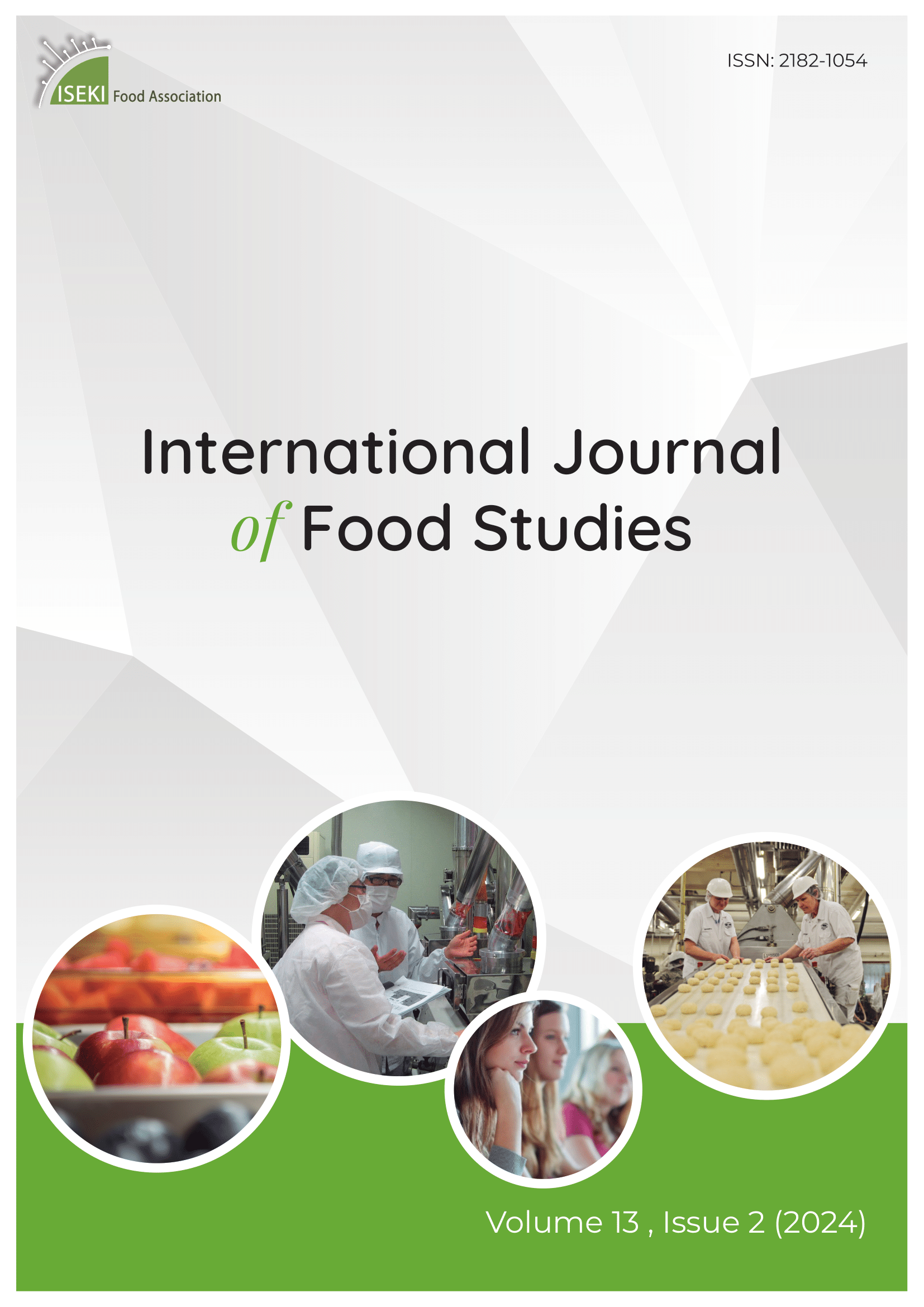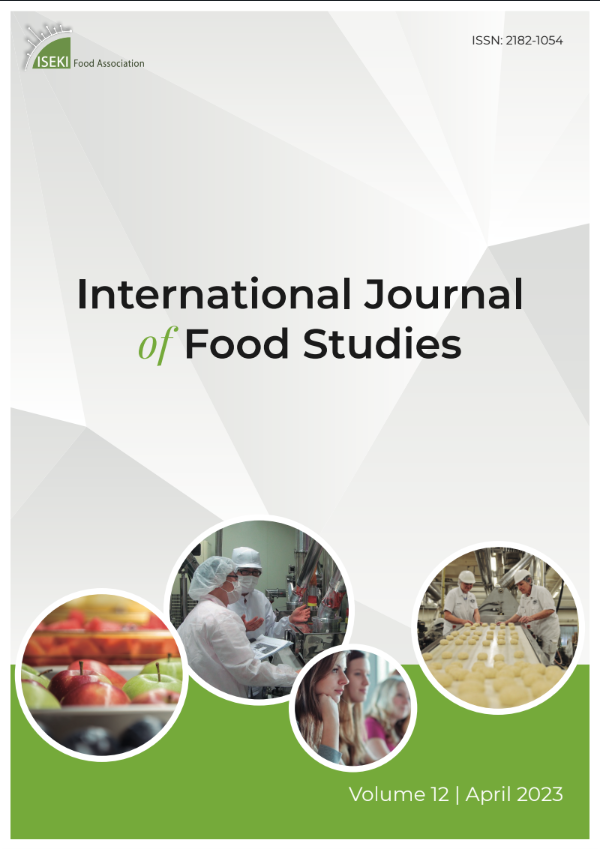Current issue

Volume 13, Issue 2, 2024
Online ISSN: 2182-1054
Volume 13 , Issue 2, (2024)
Published: 18.10.2024.
Open Access
All issues
Contents
18.10.2022.
Original scientific paper
The Effects of Processing Methods on the Quality of Arabica Kintamani Green Beans
The coffee of Arabica Kintamani is one of the most popular coffees in the world due to its specific taste. The quality of coffee beans depends on the post-harvest and processing method. Dry processing and wet processing are the most popular methods used and each process produces different quality coffee beans. The objective of this research was to study and analyze various processing methods of coffee beans and to determine the best processing method to apply by the farmers and processors. This research consisted of three processing methods for the coffee namely dried processing (natural); wet processing; and semi-wet processing (honey). The research used a randomized complete design with one factor and five replications. The study showed that dry processing (natural) produced good quality coffee beans compared with wet or semi-wet processing, with significantly higher polyphenols content of 40.80 ± 0.053 mg GAE g−1 , approximately the same caffeine content (1.19 ± 0.016 %), significantly higher antioxidant activity (% DPPH) 89.53 ± 0.229 % with an EC50 equal to 102.44 ± 0.130 mg L−1 , similar lightness 13.63 ± 8.281 and a significantly lower moisture content of 7.54 ± 0.474 %. This indicated that dry processing could be used as an alternative processing method by farmers and processors due to it being easier, cheaper, with more efficient water use as well as giving a product contained the highest levels of polyphenols and antioxidant activity that are good for human health.
I Gede Mangku, Luh Suriati, Dewa Gede Yudi Ardana, Wayan Widiantara Putra
18.04.2022.
Original scientific paper
Physical and chemical characteristics of beef marinated by cashew apple extract
Marination is one of the methods that are often used in beef processing in an attempt to obtain high quality of beef. Cashew apple extract marinade (CAM) improves the microbiological characteristics of meat by inhibiting the growth of meat bacteria. The effect of CAM on other aspects such as physical (microbiological, tenderness, cooking loss, water holding capacity and pH) and chemical (moisture, fat and protein content) characteristics of meat have not been evaluated, which would be beneficial for the utilisation of agroindustry waste in the meat industry. In this study, the effect of CAM on the physical and chemical characteristics of beef, including microbiological characteristics, tenderness, cooking loss and water holding capacity, was evaluated. CAM (0%, 10%, 20% and 30%) was used during beef processing for 4 h at refrigeration temperature. Significant effects of CAM were observed on the physical and chemical characteristics of beef. CAM increased beef tenderness and reduced total bacteria, cooking loss, moisture, fat, and protein content. The optimum concentration of CAM for which significant changes were observed in the physical and chemical characteristics of beef was 20%. Thus, cashew apple can be utilised as a promising marinade agent in beef processing with the criteria of food for specific health use. This approach will help reduce cashew apple waste and is an eco-friendly approach.
Siti Susanti, Valentinus Priyo Bintoro, Antonius Hintono, Khoirun Nisa
18.04.2022.
Original scientific paper
Storage stability of hot smoked spiced african catfish (Clarias gariepinus)
Hot Smoked Spiced Catfish (HSSC) samples prepared under optimal conditions (garlic, 7.29 g/100 ml; ginger, 7.50 g/100 ml; turmeric, 2.5 g/100 ml; soaking temperature, 38.68 °C and soaking time, 7.51 min) were stored at ambient temperature (30±2 °C) for a period of 20 days to evaluate storage stability; un-spiced hot smoked catfish served as control. Moisture Content (MC), Thiobarbutric Acid (TBA), Peroxide Value (PV), Free Fatty Acid (FFA), Total Viable Counts (TVC) and Mould Counts (MoC) were monitored at two-day intervals as a measure of the storage stability indices. Sensory attributes of the Optimized Hot Smoked Spiced Catfish (OHSSC), control (unspiced) and commercial hot-smoked catfish were determined using a preference test. The storage stability indices values for HSSC were in the range of 6.64 - 7.01% (MC), 4.50 - 13.77 mg MDA/kg (TBA), 0.20 - 2.84 mEq/kg (PV), 0.72 - 9.64% (FFA), 9.50 - 57.00 cfu/g (TVC), 8.00 - 34.50 cfu/g (MoC). The control sample values were in the range of 6.97 - 7.30% (MC), 5.51 - 14.92 mg MDA/kg (TBA), 0.23 to 2.86 mEq/kg (PV), 2.24 - 11.88% (FFA), 13.50 - 113.00 cfu/g (TVC), and 10.00 - 49.00 cfu/g(MoC). The sensory evaluation indicated that OHSSC was most preferred in all the evaluated sensory parameters. This study established the synergistic effects of garlic and turmeric on the keeping quality and sensory attributes of hot-smoked catfish with the prospect of reducing post harvest losses.
SOGO OLATUNDE, Anthonia F. Akinbisoye, Beatrice I. O. Ade-Omowaye
18.10.2022.
Original scientific paper
Drinking coffee may reduce chances of developing Alzheimer’s disease: systematic literature review and meta-analysis
Coffee is a popular beverage, and it contains caffeine, a psychoactive substance. Consuming coffee may reduce the risk of developing Alzheimer’s disease (AD). However, the association between the reduced risk of developing AD and the consumption of coffee is controversial. Therefore, we conducted a systematic literature review and quantitative synthesis meta-analysis that included dose-response analysis on the relationship between the consumption of coffee and the risk of developing AD. Based on PRISMA guidelines, we analysed standard databases of journals published between January 1999 and May 2020. We included the two population-based cohort studies and one case-control study. All studies included looked at the association between consuming many cups of coffee, the amount of coffee consumed in milligrams per day and the risk of developing AD. The systematic literature review and meta-analysis had 1670 participants with follow-up years that ranged from 5 to 21. The consumption of moderate or 3-5 cups per day reduces the risk of developing AD. The pooled relative risk and 95% confidence interval of the 3 included studies were 0.63 (0.3, 1.54). Dose-response curve analysis appears to be U-shaped. The results of the forest plot showed that there is low heterogeneity between the studies. Plotting the funnel plot and the Galbraith plot demonstrated publication bias of the three included studies. More prospective and long-term studies have to be conducted in other countries to determine the exact risk of developing AD.
Sheba R David, Raheela Dilfer Zahir Hussain, Ihsan Nazurah Zulkipli, Rajan Rajabalaya
18.04.2022.
Original scientific paper
Development and sensory evaluation of a cookie from composite sorghum and cowpea flour
There are many opportunities in the global food market for innovations, through the valorization of artisanal technologies based on the local raw material. In this context we were interested in the development of cookies based on a local variety of sorghum from northern Cameroon, the so-called S35 sorghum variety and a local cowpea from northern Cameroon the so called "sekem variety". During the production of flours for cookies, the extraction yields were as follows: 46.67% for sorghum flour and 55.60% for cowpea flour. It was found that it was technically possible to produce these types of cookies. Several production trials were done and submitted to a panel for sensory analysis. The results showed that amongst different produced cookies, the one with 45% sorghum, 40% wheat, and 15% cowpea was the most appreciated by the members of the test panel. 70% of panelists considered them as "very good" against 30% who considered them as "good". 60% of test panelists indicate that cookies with 50% sorghum, 40% wheat and 10% cowpea were "good", against 40% who thought they were "not too bad". Meanwhile 50% of the test panelists considered that the cookies made of 55% sorghum, 40% wheat and 5% cowpea were "good" against 50% who indicate this as "bad" and "not too bad". Proximate analysis of the cookies of trial 3 showed that it contained about 12.50% proteins, 84.10% carbohydrates, 27.34% lipids and 1.50% fiber.
DJOULDE DARMAN Roger, Fadi Goygoy, Djomdi
18.10.2022.
Original scientific paper
The Effect of Sterility Values and Retort Temperatures on the Change of Physical and Sensory Properties of a Canned Mushroom Product
This research aimed to study the effect of sterility values on physical quality (drained weight, brown colour index, and texture) and sensory properties of canned Agaricus bisporus mushrooms processed at different retort temperatures (115, 121, and 130 °C) and processing times (2-97 minutes). Mushrooms in brine solution media packaged in 300x407 cans were heated in industrial-scale horizontal static retorts at different retort temperatures for specific processing times to reach different F0-values. The canning process was carried out following commercial production procedures in one of the mushroom canning factories. Measurement of heat penetration into the product was carried out using a protocol established by the Institute of Thermal Process Specialists (IFTPS), and the sterility values (F0) were calculated. Our results indicated that the physical and sensory properties of canned mushrooms were not only affected by sterility value but also by the combination of temperature and time used to process the product. At the same level of sterility, a higher retort temperature (130 °C) resulted in canned mushroom with a lower browning rate, an improved texture profile (decreased hardness, increased chewiness, and shear force), a sweeter taste, and increased intensity of umami taste. However, the canning process at a temperature of 130 °C resulted in a greater reduction of the drained weight as compared to that of canning at 115 °C and 121 °C.
Didik J. Pursito, Eko Purnomo, Dedi Fardiaz, Purwiyatno Hariyadi
18.10.2022.
Professional paper
Impact of Different Drying Methods on Nutritional, Colour Change, Solubility and Microbial Count of Selected Herbal Plant Powders
The research aimed to study the effect of drying processes (spray and freeze drying), and feed concentrations (80%, 65% and 50% of plant in water, w/w) on physicochemical and microbiological characteristics of star gooseberry (Sauropus androgynus), ceylon spinach (Basella alba), and cowslip creeper (Telosma minor ). After drying, the powder recovery of herbal plant powders was up to 77.47%. The aw and moisture content of spray-dried powder (SDP) were lower than that of freeze-dried powder (FDP). The drying method did not significantly affect nutritional values of both powders, whereas the feed concentrations markedly affected the nutritional values of the powders. The fibre and fat contents of powder prepared from 80% feed concentration had the highest values (p<0.05). The dried star gooseberry powder was rich in protein (13.01-16.81%) and fibre (5.03-5.52%). The colour of FDP represented a smaller change than that of SDP. The dried powders prepared by 80% showed the highest solubility, up to 85.44%. The microbial counts of SDP were lower than that of FDP. The colour might well have been preserved by freeze drying, whereas a low moisture and microbial count were likely due to the spray drying.
Wijitra Liaotrakoon, Vachiraya Liaotrakoon, Wanpa Wongsaengthama
18.04.2022.
Original scientific paper
Comparisons between flour qualities produced by three different mills: buhler, quadrumat, and industry mills
Three types of mills (Buhler, Quadrumat, and industry mill) have been used to determine the effect of mill type on the quality of the produced flour. Quadrumat and Buhler mills are usually used to produce flour at a laboratory level. Flour quality has been determined physically, chemically, and rheologically. Results showed that the particle size of flour produced by Buhler mill (FPB) was finer (mostly less than 132 μm) than other produced flour, while flour produced by Quadrumat mill (FPQ) had 8% particle size bigger than 50gg, which is more than Iraqi accepted limit (5%). The moisture content of FPQ exceeded the moisture content limit (14%). While, all flour produced by industry mills (FPI) was within the Iraqi standard in term of particle sizes and moisture content. Gluten content of FPB was higher than other produced flours; however, most increments were not significantly different. The results also showed that using different mills has no clear effect on the gluten index and alpha-amylase activity. Farinogram and extensogram results showed that FPQ was stronger than other produced flour followed by FPI. In conclusion, the quality of FPQ was closer to the quality of FPI, however, Quadrumat mill needs to be adjusted to produce flour with finer particle sizes and lower moisture content. The Buhler mill, on the other hand, needs to be adjusted to produce flour with bigger particle size. Both laboratory mills (Quadrumat and Buhler) need to be adjusted to produce flour that expresses FPI correctly.
Abeer Alhendi, Tamadher H. Ahmad, Wasan S. Albayati, Balsam Q. Almukhtar, Zahraa K. Ali, Nuhoodh K. Al-Hayani
18.10.2021.
Original scientific paper
Effect of storage on physico-chemical, microbiological and sensory characteristics of goat milk fermented by Lactobacillus strains isolated from minas artisanal cheeses
Lactobacillus spp. are lactic acid bacteria which have important implications for the food industry due to their fermentation capacities. The aims of this research were to produce fermented goat milks with Lactobacillus plantarum B7 and Lactobacillus rhamnosus D1, isolated from Brazilian artisanal cheeses, and to evaluate their physico-chemical, microbiological and sensorial qualities during 30 days of storage at 7°C. The goat milks, fermented by B7, D1, co-culture and a Lactobacillus casei Shirota control, possessed acceptable physico-chemical characteristics to meet fermented milk standards established by Brazilian legislation and maintain the viability of Lactobacillus spp. throughout the shelf life of the products. The products were microbiologically safe. D1 fermented goat milk gave higher consumer sensory quality acceptance and purchase intention (p<0.05) than other treatments, thus Lactobacillus rhamnosus D1 is recommended for fermented goat milk production.
Gustavo Valente, Leonardo B. Acurcio, Ranier C. Figueiredo, Felipe M. Sant'Anna, Rommel F. Brito, Luigi P. V. Freitas, Andréia M. Silva, Marcelo R. Souza, Cláudia F. A. M. Penna
18.05.2021.
Original scientific paper
Effect of Retort Processing on Low Sodium Instant Noodle Seasoning Based on Oil-in-Water Emulsions
Increasing consumption of instant noodles with high sodium content could elevate the risk of cardiovascular disease. Making instant noodle seasoning in the form of an oil-in-water emulsion was expected to improve the perception of salty taste without increasing the use of salt. However, the oil concentration in the emulsion affects the perception. The addition of antioxidant and retort processing was needed to overcome the nature of the emulsion that was quite susceptible to oxidation and microbial contamination. Preliminary research determined the optimum concentration of oil and antioxidant based on physical characteristics, the perception/gustation of saltiness, and emulsion oxidative stability and the results were used for further research. The final part of the research determined the effects of retort processing on emulsion stability, the perception of saltiness, and the degree of microbial contamination. Three different oil concentrations (26, 27, and 28%) and three types of antioxidants (natural vitamin E, ascorbyl palmitate and mixed tocopherol) were applied to the instant noodle seasoning oil-in-water emulsions. The results showed that using 28% oil and mixed tocopherol had the most stability, was more viscous, and had optimum salty taste perception, which significantly extended the shelf-life of the emulsion compared with the others. Retort processing for 21.5 minutes in 123.5 °C was applied to the seasoning emulsion with 28% oil content and mixed tocopherol. Although, the microbial contamination was significantly reduced, neither the stability of emulsion nor the perception of salty taste was significantly changed by the process.
melanie cornelia, Angeline Apriliana, Irene Triyanti











